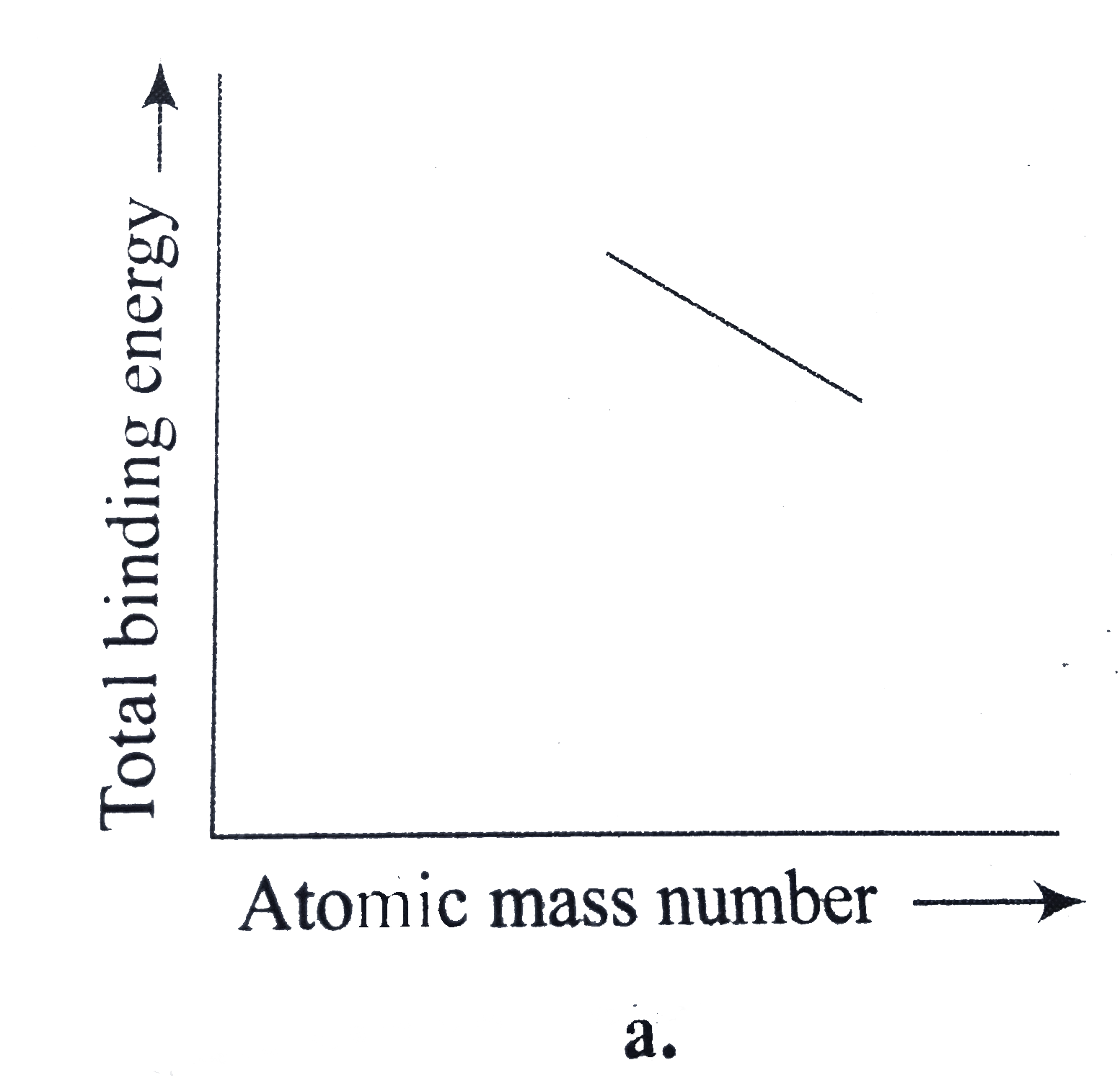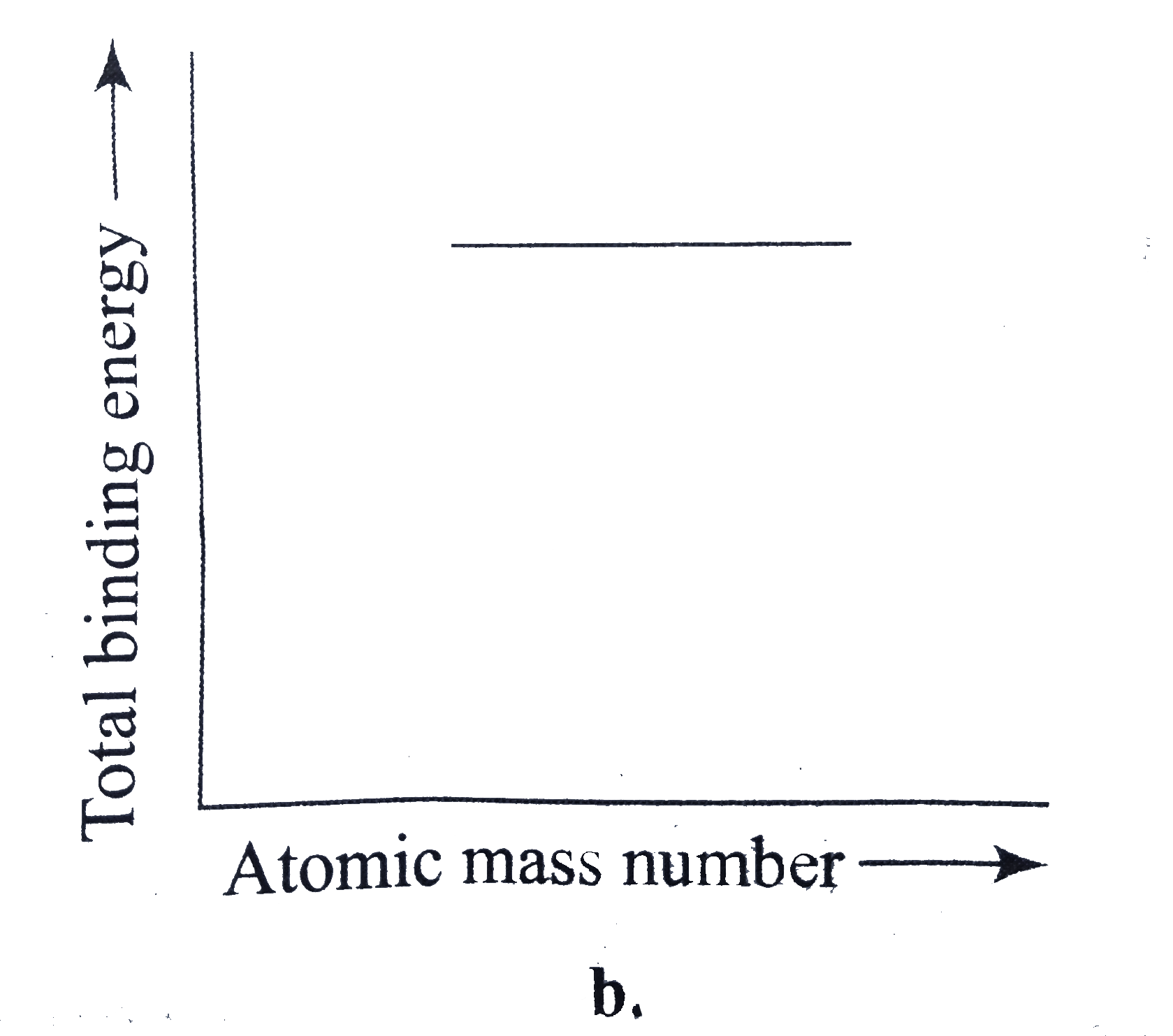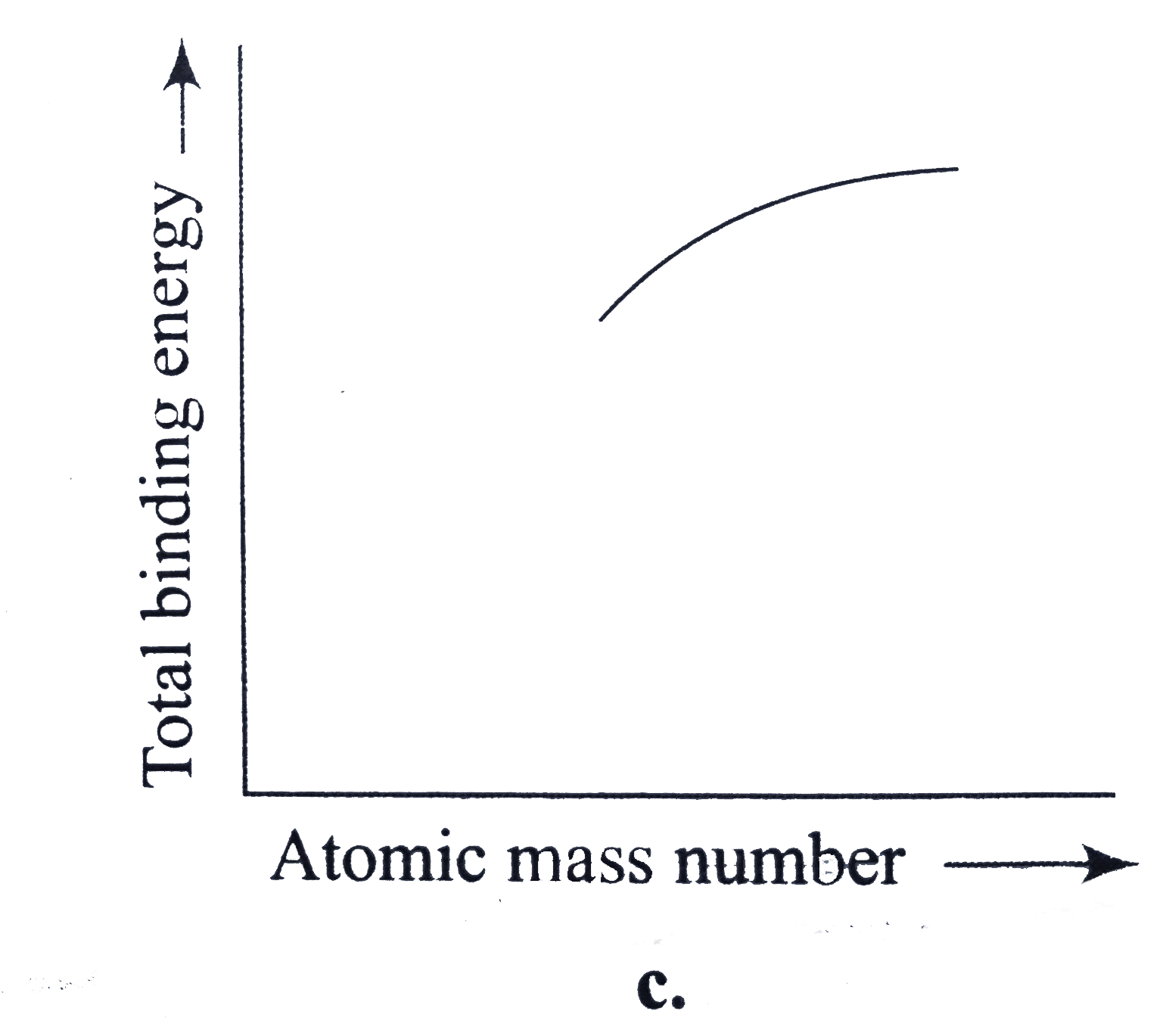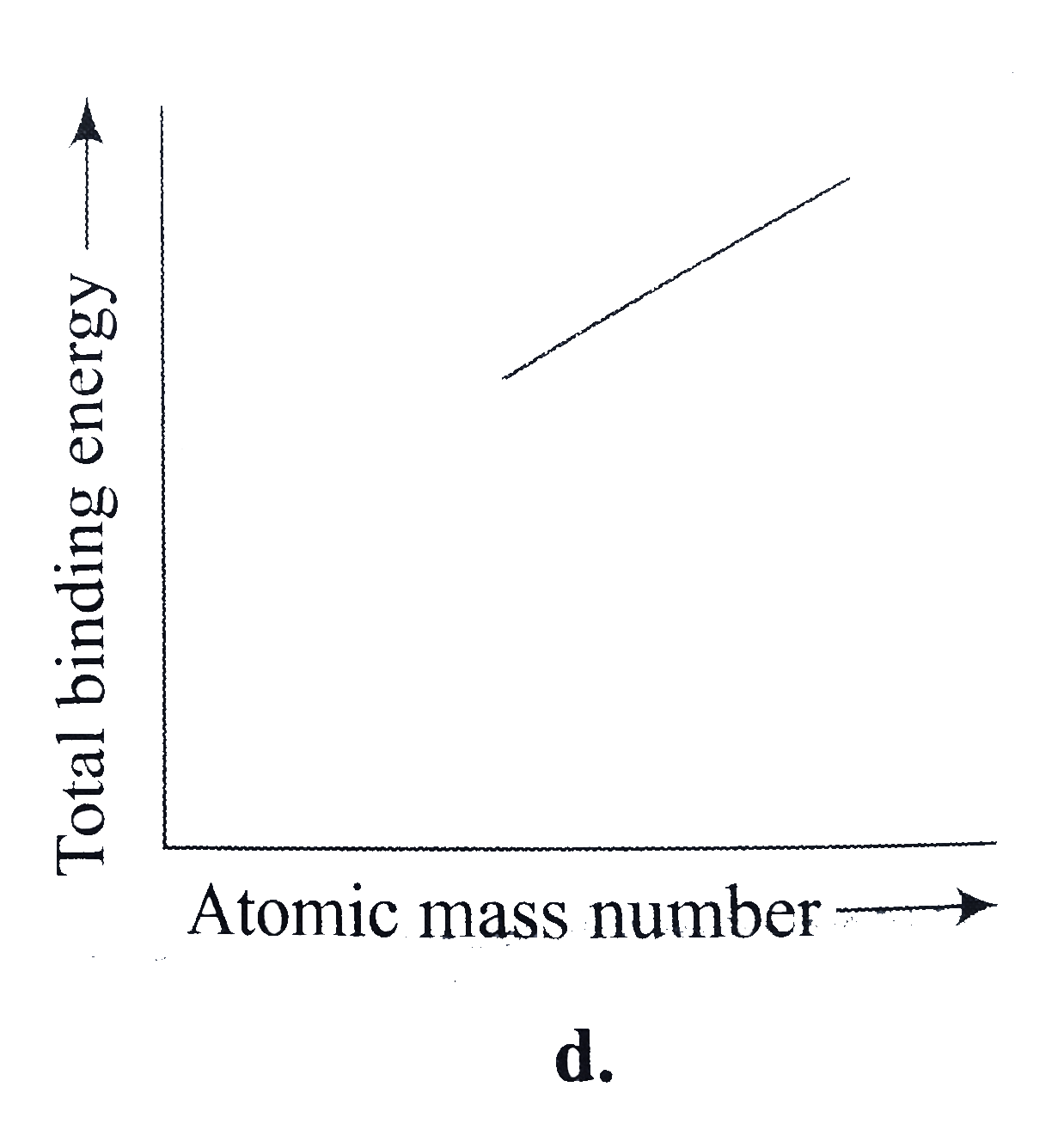The compound unstabel nucleus .23692U often decays in accordance with the following reaction
.23692U→.14054Xe+.9438Sr + other particles
During the reaction, the uranium nucleus ''fissions'' (splits) into the two smaller nuceli have higher nuclear binding energy per nucleon (although the lighter nuclei have lower total nuclear binding energies, because they contain fewer nucleons).
Inside a nucleus, the nucleons (protonsa and neutrons)attract each other with a ''strong nuclear'' force. All neutrons exert approxiamtely the same strong nuclear force on each other. This force holds the nuclear are very close together at intranuclear distances.
Which of the following graphs might represent the relationship between atomic number (i.e., ''atomic weight'') and the total binding energy of the nucleus, for nuclei heavier than .9438Sr ?
A

B

C

D

Video Solution
Text Solution
The correct Answer is:c
Graph (a) would correcrtly show the binding energy per nucleons, but this differs from the total binding energy of the nucleus. The total binding energy takes into account not only the binding energy takes into account not only the binding energy per nucleon, but also the number of nucleons.
To understand this subtle point, compare .9438Sr to .23632U. As the passage states, .9438Sr has a higher binding energy per nucleon. Here,
.9438Sr binding enrgy per nucleon ≈9MeV
.23632U binding enrgy per nucleon ≈7MeV
But .23632U still has a higher total binding energy, simply because it contaisn more nucleons. Indeed, since total binding energy of a nucleus=binding energy per nucleon ×number of nuclei, the total binding energies are
.9438Sr×(94νc≤ons)≈846MeV
.23632U×(236νc≤ons)≈1650MeV
So, as atomic mass increase linearly with atomic mass. It incerease at a smaller and smaller rate, precisely because the binding energy per nucleon decreases. Indeed, since 'atomic mass number' specifies the number of necleons, the binding energy per nucleon is simply the slope of a binding energy vs. atomic mass number graph. Between strontium and uranium, this slope decrease, as just explained. Thus, the answer must be (c) rather than (d).
|
Topper's Solved these Questions
- NUCLEAR PHYSICSBOOK - CENGAGE PHYSICSCHAPTER - NUCLEAR PHYSICSEXERCISE - Integer
6 Videos
- NUCLEAR PHYSICSBOOK - CENGAGE PHYSICSCHAPTER - NUCLEAR PHYSICSEXERCISE - Fill In The Blanks
5 Videos
- NUCLEAR PHYSICSBOOK - CENGAGE PHYSICSCHAPTER - NUCLEAR PHYSICSEXERCISE - Single Correct Option
182 Videos
- Moving charges and magnetismBOOK - CENGAGE PHYSICSCHAPTER - Moving charges and magnetismEXERCISE - Question Bank
20 Videos
- NUCLEIBOOK - CENGAGE PHYSICSCHAPTER - NUCLEIEXERCISE - QUESTION BANK
59 Videos
Similar Questions
Knowledge Check
The compound unstabel nucleus .23692U often decays in accordance with the following reaction
_(92)236U→.14054Xe+_(38)^(94)Sr + other particles
During the reaction, the uranium nucleus ''fissions'' (splits) into the two smaller nuceli have higher nuclear binding energy per nucleon (although the lighter nuclei have lower total nuclear binding energies, because they contain fewer nucleons).
Inside a nucleus, the nucleons (protonsa and neutrons)attract each other with a ''strong nuclear'' force. All neutrons exert approxiamtely the same strong nuclear force on each other. This force holds the nuclear are very close together at intranuclear distances.
In the nuclear reaction presented above, the ''otter particles'' might be .AAn alpha particle, which consists of two protons and two neutronsBtwo protonsCone proton and one neutronDtwo neutronsThe compound unstabel nucleus .23692U often decays in accordance with the following reaction
.23692U→.14054Xe+.9438Sr + other particles
During the reaction, the uranium nucleus ''fissions'' (splits) into the two smaller nuceli have higher nuclear binding energy per nucleon (although the lighter nuclei have lower total nuclear binding energies, because they contain fewer nucleons).
Inside a nucleus, the nucleons (protonsa and neutrons)attract each other with a ''strong nuclear'' force. All neutrons exert approxiamtely the same strong nuclear force on each other. This force holds the nuclear are very close together at intranuclear distances.
Why is a .42He nucleus more stable than a .43Li nulceus?AThe strong nuclear force is larger when the neutron to proton ratio is higher.BThe laws of nuclear physics forbid a nucleus from contaning more protons than neutrons.CForces other than the strong nuclear force make the lithium nulceus less stable.DNone of the above.The compound unstabel nucleus .23692U often decays in accordance with the following reaction
.23692U→.14054Xe+.9438Sr + other particles
During the reaction, the uranium nucleus ''fissions'' (splits) into the two smaller nuceli have higher nuclear binding energy per nucleon (although the lighter nuclei have lower total nuclear binding energies, because they contain fewer nucleons).
Inside a nucleus, the nucleons (protonsa and neutrons)attract each other with a ''strong nuclear'' force. All neutrons exert approxiamtely the same strong nuclear force on each other. This force holds the nuclear are very close together at intranuclear distances.
A proton and a neutron are both shot at 100ms−1 toward a .126C nuleus. Which partilce, if either, is more likely to be absorebed by the nucleus?AThe protonBThe neutronCBoth particles are about equally likely to be absorbed,.DNeither particle will be absorbed.
For atomic nuclei, the binding energy per nucleon
View SolutionThe average binding energy per nucleon is maximum for the nucleus
View SolutionThe binding energy per nucleon of nucleus is a measure of its.
View SolutionAs the mass number A increases, the binding energy per nucleon in a nucleus.
View SolutionNuclear energy is released in fission since binding energy per nucleon is
View Solution
